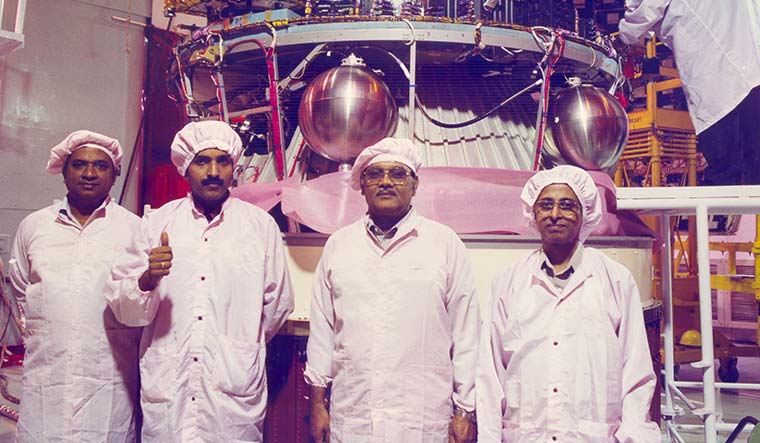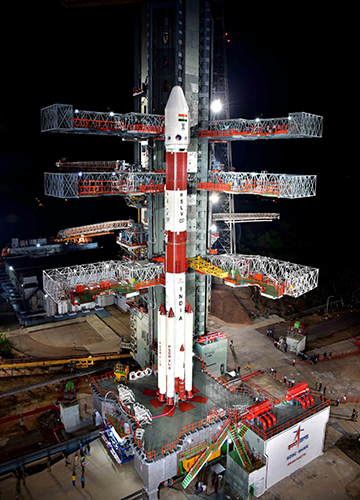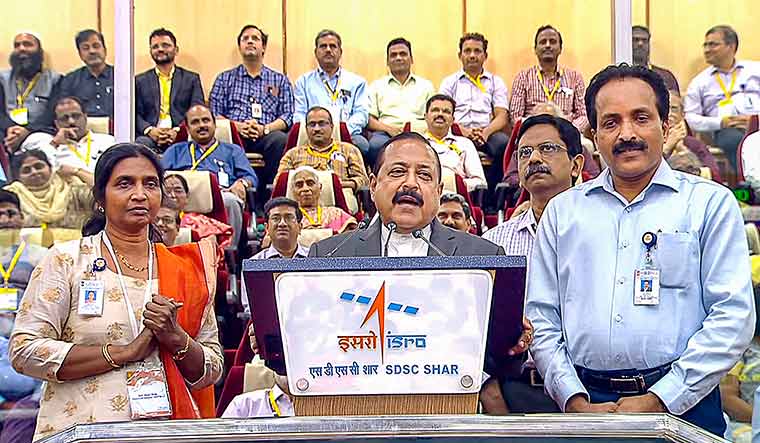Interview/ S. Somanath, chairman, Indian Space Research Organisation, and secretary, department of space
A man waited outside a hall in Kochi. Inside, members of The Institution of Engineers were listening to ISRO Chairman S. Somanath deliver a keynote address. The waiting man was dressed smartly in a checked shirt and cream trousers. I felt that I had seen him somewhere and then recognised him in a flash―A.P. Velappan, a retired sub inspector of the Kerala Police and Somanath’s classmate from school. I had met him while researching this article.
Velappan said that he was waiting outside as he felt out of place at the engineers’ event, but could not pass up the rare chance to see his old friend. As we waited together, I wondered whether Somanath would notice him, surrounded as he surely would be by a gaggle of excited engineers. He was indeed mobbed when he came out, but he did notice his friend. “Velappan”, he called out joyously, before gathering him in a bear hug and pulling him aside for a brief chat and a selfie.
Later, during our car ride to the Grand Hyatt Kochi, where our interview had been arranged, Somanath spoke in detail about how Velappan was a constant source of support in school. In fact, Somanath does remember a lot. He was visibly excited when I mentioned that I had met one of his primary school teachers, K.J. Chitrangadamma. “Teacherne kando (Oh, did you meet teacher?),” he asked excitedly, before sharing his memories about her. His keen recollection of even minor events, attention to detail and clarity of thought are remarkable―qualities that are clearly serving him well in his career, too.
In a candid interview, Somanath opened up about his journey and explained India’s ambitious space endeavours, both present and future. Edited excerpts:
Q Was the success of Chandrayaan-3 the pinnacle of your career?
A I don’t think so. It is just another milestone, but it has created a great impact because landing on the moon was difficult and [many] earlier attempts had failed. Others were not able to go there (the lunar South Pole) and then India did it.
Q How crucial were the lessons from the failure of Chandrayaan-2?
A It is only the failure of Chandrayaan-2 that helped us with the soft landing of Chandrayaan-3. Otherwise, it would not have happened. Based on the data, we understood what went wrong, did more tests and validated them. And that is why Chandrayaan-3 became successful. Achieving a perfect mission in the first attempt is very difficult. Of course, we have accomplished that in many cases. It all depends on how well we understand the whole process mathematically.
 Proud moment: Prime Minister Narendra Modi and Somanath after the success of Chandrayaan-3 Mission at ISRO Telemetry Tracking and Command Network in Bengaluru | PTI
Proud moment: Prime Minister Narendra Modi and Somanath after the success of Chandrayaan-3 Mission at ISRO Telemetry Tracking and Command Network in Bengaluru | PTI Q You have been with ISRO for four decades. Could you share some memories from your early days at the agency?
A I still remember the day I joined ISRO. I went to the huge complex of Vikram Sarabhai Space Centre in Thiruvananthapuram. We (new recruits) went to the main building where we were received by Dr Ramanathan, brother of Nobel laureate Subrahmanyan Chandrasekhar. He was wearing a suit. He asked us where each of us wanted to work. I said I wanted to be where something is happening and was sent to the PSLV project. I met Madhavan Nair, who was then associate project director of PSLV. I spent one month [in the VSSC campus] and then shifted to Valiyamala [within Thiruvananthapuram district], where a new complex was coming up for PSLV.
When I joined, PSLV was still on the drawing board and there were no seniors to guide us. So, we had to learn a lot by ourselves. We worked at the mechanical integration launch complex; mechanical integration was not a top-end engineering domain at that time. We were not into rocket design, propulsion or core engineering. However, we created a huge change. We made it into a core engineering domain. We added more and more faculties to it; more analytics, more engineering skills and more specialists came out of it.
That team produced many good rocket engineers, good integrators and good leaders. Five of us shared an office―B. Jayakumar later became the PSLV project director and GSLV Mark-III project director; M. Mohan is currently the Human Space Flight Centre director; Kishorenath Vukkadala became the associate director of VSSC. So, from that room, multiple leaders came up.
 August company: Scientists E.J. Francis, N. Narayanamoorthy and Suresh Ponnen with Somanath.
August company: Scientists E.J. Francis, N. Narayanamoorthy and Suresh Ponnen with Somanath. Q Compared with when you joined, is it more challenging now to attract top talent to ISRO?
A The issue today is different. ISRO is a government organisation and it can provide only certain levels of career progression. We still get very good people and I do not feel that we have any shortage of good people. For every 100 vacancies advertised for engineers, we get 1.5 lakh applicants. But, those applicants are not all from IITs, [though] these are bright people. People say the cream is in IITs, but I know that is not true. I find the cream everywhere. It is passion that makes you part of the cream. When you put 1,000 people in IITs, there are 10,000 people who are competent enough to get into IITs but did not get the opportunity. If you can attract them and inspire them, they can do wonderful things.
Q How do you push people to bring out the best in them?
A There is no need to push people. I think it is a wrong management tactic. The best way is to inspire people. Pushing people to do things is not a sustainable model. The right model is to give them power. Empower them. My bosses, especially S. Ramakrishnan―who was my boss for 20 years―did the same to me. So, I would like to do the same to others.
Q Are there any plans to revise the pay structure at ISRO?
A It may not be possible to revise the pay structure in ISRO alone. Because it is a government job, which cannot be flashy like a private job. So, it will continue to have its limitations on pay structure. Also, if you are trying to attract people through higher pay, only some people will get attracted. What we want is continuity; people who can learn and develop and [put other things above] monetary benefits. Finding such people is more important.
 New horizons: ISRO’s PSLV-C57 carrying Aditya-L1 spacecraft at the launch pad at Satish Dhawan Space Centre in Sriharikota | PTI
New horizons: ISRO’s PSLV-C57 carrying Aditya-L1 spacecraft at the launch pad at Satish Dhawan Space Centre in Sriharikota | PTI Q Did coming from a middle-class background help you at ISRO?
A Yes. People who come from such backgrounds have a greater desire to excel than people who have already seen the comforts of life. Their questions are different, their measure of life is different and they are more passionate compared with those who are already affluent.
Q ISRO is known for its cost-effectiveness. How do we manage that in a domain like space?
A We can do things at a substantially lower cost than in western countries primarily because of our approach. First, in terms of design, we use a low-cost approach. Second, in model making, our numbers are low; we look at simulations more than actual physical hardware testing. Then we refurbish and reuse hardware multiple times, instead of using it in one test and throwing it away. For instance, we retrieved the hardware used in the [Gaganyaan] Test Vehicle Mission, which fell into the sea. We are going to clean it up, reassemble and reuse it. In any other country, it would go to a museum. Not here. So, our overall cost will come down and our manufacturing cost and engineering cost are lower compared with many others. So many aspects go into cost reduction.
Q The budget allocation for the space programme has grown in the last decade. It is now around Rs13,000 crore. What should be the ideal allocation, especially in light of ISRO’s ambitious goals?
A We here never had any issue with the budget. We have always got the money we asked for. Last year, we were unable to spend all the money we got. This money goes in various headings; salary, infrastructure maintenance, facility maintenance, research and projects. Most of the money was spent on projects, like building rockets and launching satellites. But that is only one part of the job, our core is technology development and that had only a small [spending]―Rs500 crore. We want to increase that by a few fold. So, I am looking at how new technology projects can be initiated so that we can develop that core competency.
So, we absolutely do not have any difficulty with money. The more technology we can propose…, for example, if we propose a quantum satellite, the government will approve it.
Q In an earlier interview with THE WEEK, you mentioned that ISRO is working on over 1,500 new technologies. Could you share some of the exciting technology ISRO is developing?
A We are looking at how to refuel a satellite, how we can de-orbit a dead satellite, how a software-driven satellite can be built, which can be reprogrammed―frequencies and footprints can be changed over time. We are looking at how we can do additive manufacturing (3D printing) in space. We are also looking at docking and assembly of big structures robotically in space.
 Union Minister of State for Science & Technology Jitendra Singh with ISRO Chairman S. Somanath and Nigar Shaji, project director of the ‘Aditya-L1’ mission, after the successful launch of the mission in Sriharikota | PTI
Union Minister of State for Science & Technology Jitendra Singh with ISRO Chairman S. Somanath and Nigar Shaji, project director of the ‘Aditya-L1’ mission, after the successful launch of the mission in Sriharikota | PTI Q Coming to some of the major upcoming projects, we had the first Test Vehicle Mission for Gaganyaan in October. Could you share the progress made in preparing for human space flight?
A We were trying to do this launch much earlier, but cancelled it; primarily because of the delays in engineering, procurement and industry support. The first human space flight mission is scheduled for 2025. But before that, we have 20 major tests that need to be completed―which include the test vehicle flights―and the minor tests which are in the hundreds. So, if you encounter many failures, then, of course, it can have an impact. But, today I can tell you that [the process is] going at a fast pace in terms of engineering and we have a full grip on it.
Q The Aditya-L1 programme, ISRO’s inaugural solar mission, is projected to reach the Lagrange point (L1) around mid-January 2024. How will this mission prove vital for the world?
A To study the sun has been an important activity for many spacefaring nations. Many missions have been launched to study the sun, the latest being the Parker Solar Probe of the US. This is because the sun has so much influence on the climate and weather. Primarily, the sun is not a static body; it is a dynamic object having something called solar coronal emission. The Aditya-L1 mission is looking at how solar emissions take place, how to understand it and how to model it.
It is a unique satellite and has seven instruments, built by Indian scientists, which are [equipped] with different regimes of observation. That means we are looking at solar activity in various ways. They are correlated measurements. Such a mission has never been done.
L1 is a unique location. You can look at the sun 24×7 and communicate with earth continuously.
Aditya L1 will help our scientists make good connections between observations of solar coronal mass ejection, its mathematical modelling, prediction of its influence on earth’s magnetic sphere, effects on facilities like communication networks and power buses.
Q Could you explain the XPoSat mission?
A XPoSat is an X-ray polarimetry satellite [for] observing pulsars, X-ray emitting stars―primarily the black holes which eat other stars and draws the mass into itself. Once you study them in polarimetry, you will be able to find out more details about such activity, because it is not visible to you. For that, the satellite is carrying a very complex, unique and sensitive instrument, a polarimeter of X-ray.
Q Could you explain the objectives of the SPADEX mission and its significance?
A SPADEX is an experiment to dock two satellites in space. We will send two satellites. First, they will be connected. After reaching orbit, they will separate, move a few kilometres apart and again autonomously come together and dock. So, docking and de-docking will be demonstrated. It is crucial, because if you have to do human space flight, you have to build a space station. We must have the capability to dock and that docking is an automated process. You cannot control it from the ground. It has to be done using sensors and algorithms. We have created such capabilities. The satellite is at the final assembly [stage]. We should be able to launch this mission at the start of next year. It is a low-cost mission, with small satellites for this experiment and after that, it will convert itself into some other experiment.
Q What is the expected launch date for the NISAR mission―a major collaboration with NASA?
A We want to launch it in the beginning of the second quarter of 2024, around March-April. The satellite is currently fully integrated. It is undergoing a major test.
Q You have said that the establishment of the Kulasekarapattinam launch pad in Tamil Nadu will enable ISRO to launch smaller rockets and accommodate private players. What other significant steps have been taken to attract and integrate private entities into space technology?
A A government announcement in 2020 which opened up the space sector―called space sector reforms―enabled all this to happen. After I took over as chairman, my job was to implement it to the fullest, creating the framework and policy, and helping us to implement the space sector reforms. In 2023, we came out with a space policy, which clearly defines the roles and responsibilities of all the entities in space―ISRO, department of space and NSIL (NewSpace India Limited; a PSU). We are looking at how to help the private ecosystem to handle this. So, as per the new policy, private [players] can do anything in space and the DoS and ISRO should help them. Public-funded research outcomes should go to them. The facilities of ISRO should be shared with them―provided they are available. A regulator and authoriser is created to help private people build and launch authorised rockets.
Many startups have come up and we are helping them in various ways―technologies, facility sharing, advisers, authorisations, networking, funding help, and [attracting] FDIs.
Q In which domain related to space technology do you anticipate increased private investment in the coming years?
A In every area. In fact, we did research through an agency. That study indicates that there could be a substantial increase in private investment in various fields. It will be highest in rocket building, second highest in satellites and the least in application. But, revenue generation and overall business will be higher in application.
So, what I expect is more and more space-based applications from private firms, like remote sensing imaging, communication, IoT (internet of things) and drone applications. Already, there are many companies working in this domain in India―MapMyIndia, SatSure and Basundhara, for example. There is also the next set of companies, which are satellite building companies. Companies like Pixel, Azista and Dhruva have all started building their satellites. The same with rocket building. But, only two companies are showing promise in that area―Agnikul and Skyhook. Both have come up with reasonably good design, capability and strength. And they are getting ready for small launches.
Q India joined the Artemis Accords with the US. What are the advantages?
A This accord is a non-binding agreement between the US and India. We say that we will have a common way of exploring outer space and planets and we will create a framework for doing it. It has no commercial interests. Of course, America is developing the capability for moon missions like the Artemis programme and the Artemis Accords is a prelude to it.
I am looking at it from the point of view of joining a large movement of going to the moon and creating a collaborative framework, because so many countries will come into it. So we may need to be with some group of people who have access to high technology and our development in the moon mission will also be parallel to that, not at cross-purposes. For example, when you design a mission to the moon, we will be able to operate our systems together. We can take help in case of contingency and in case of failure, there will be somebody to help you. So, all these possibilities exist when you join such accords.



